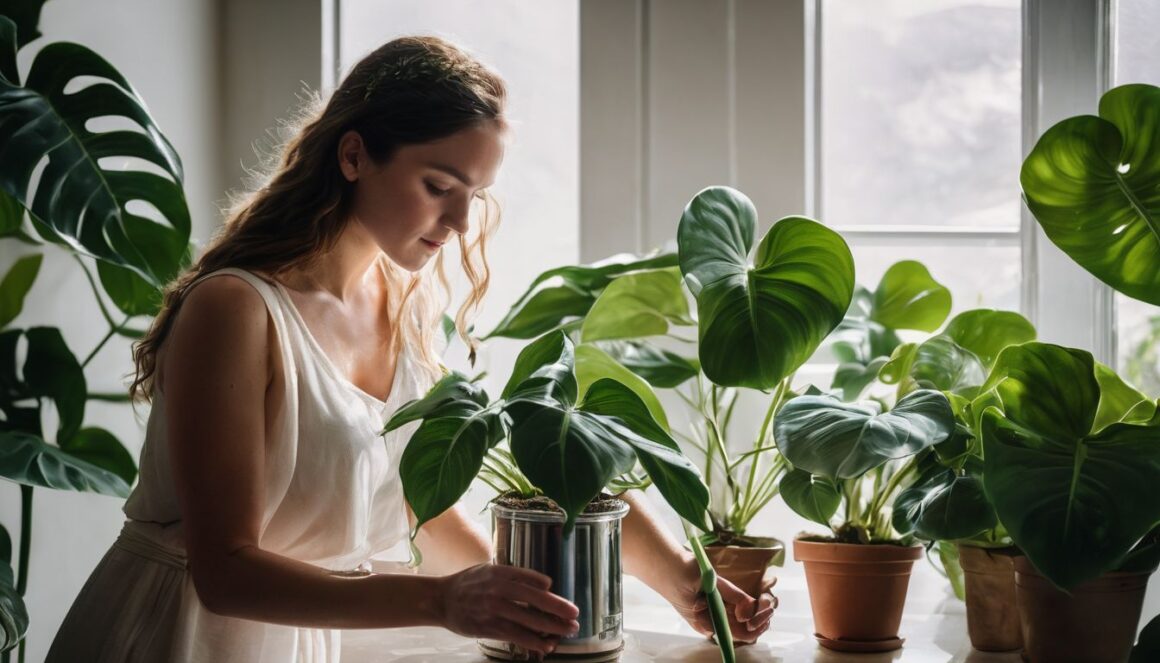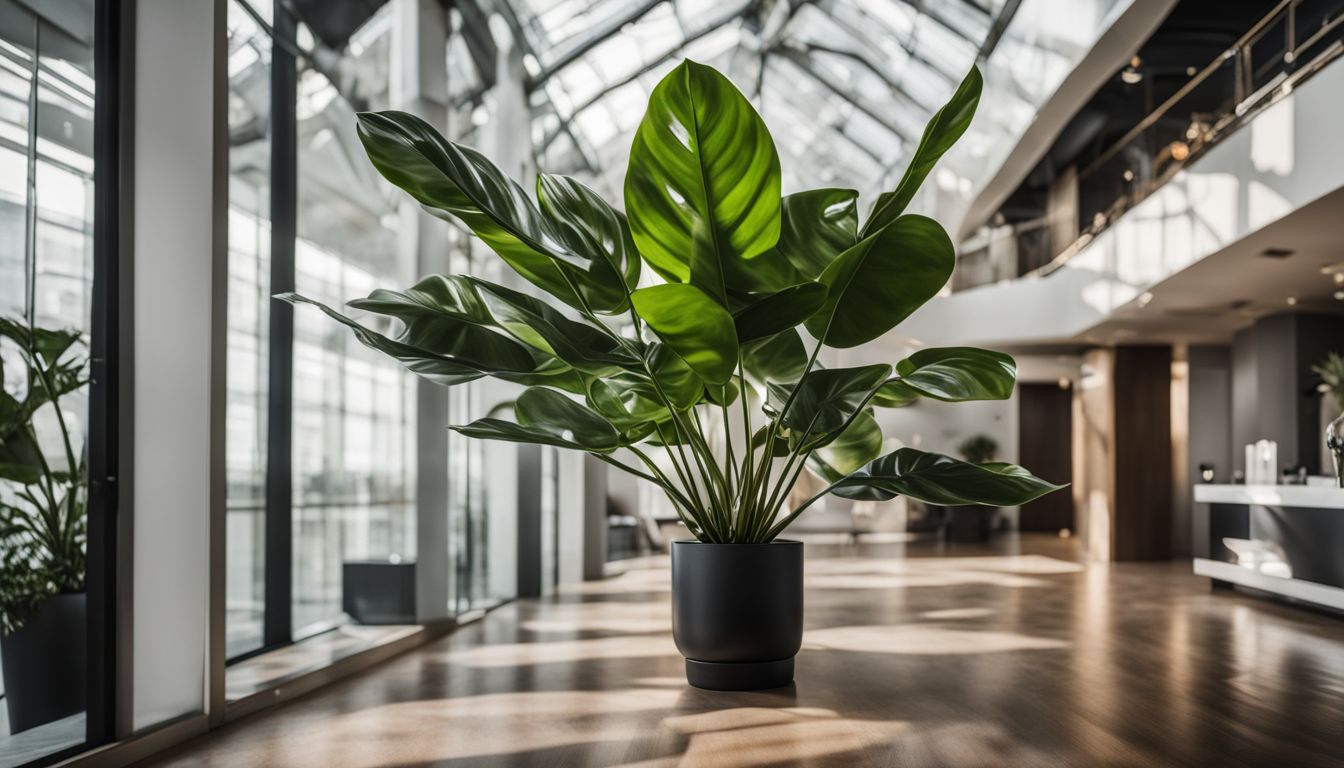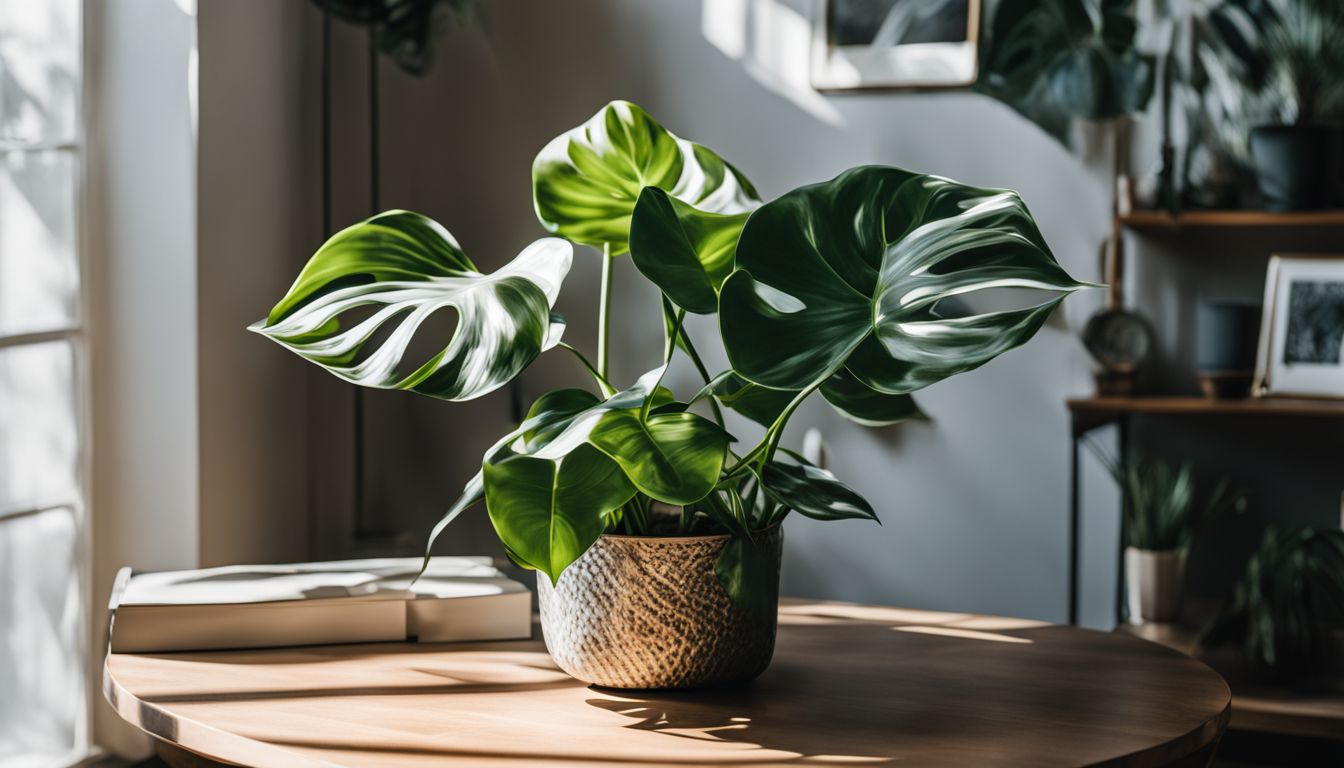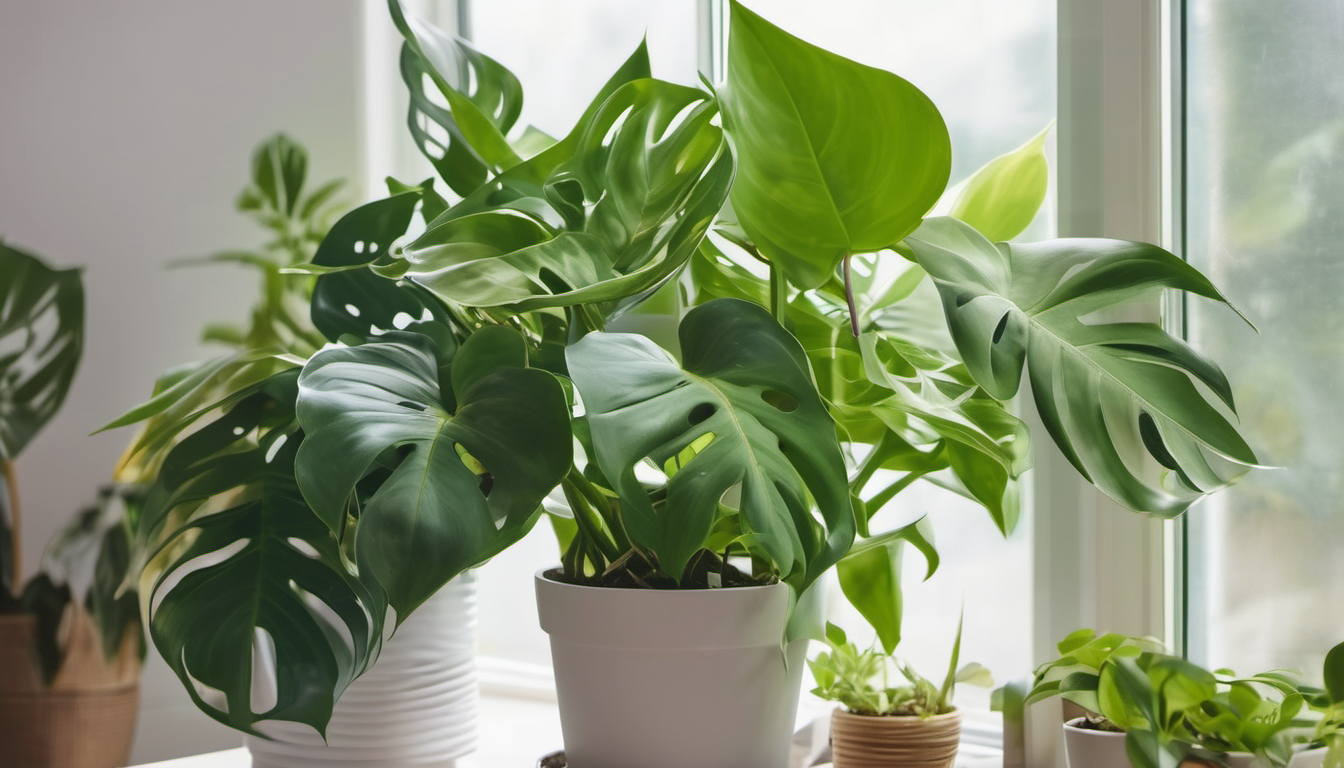Struggling to keep your houseplants thriving? The Silver Sword Philodendron, known for its striking silvery foliage, is a real crowd-pleaser in the plant world. This blog post will guide you through the essentials of nurturing this shimmering beauty to its full potential.
Dive into a greener life with our easy care tips!
Vital Aspects
- The Silver Sword Philodendron is a plant from Brazil that grows well in bright, indirect light and loose, well-draining soil.
- It needs to be watered when the top inch of soil feels dry but do not overwater as this can cause yellow leaves or brown spots.
- Keep the humidity moderate to high like its rainforest home. Use a pebble tray with water or mist the leaves to help.
- Fertilize once a month during spring and summer with diluted liquid fertilizer for healthy growth.
- Watch out for pests like spider mites and mealybugs. Keep your plant clean and check it often to avoid these issues.
What is the Silver Sword Philodendron?
The Silver Sword Philodendron is a tropical plant native to Brazil, known for its silvery hues and sword-shaped leaves. It thrives in moderate to bright indirect light, making it a popular choice for indoor plant enthusiasts.
Native to Brazil
Silver Sword Philodendron comes from Brazil’s lush rainforests. This special plant loves the warm, damp air of its home country. In these forests, it climbs trees and shows off its beautiful silvery leaves that look like swords.
Brazil is a great place for many plants because it has lots of light but not too much sun, just like what Silver Sword needs to grow well. Soil there is perfect for this plant too – loose and drains well so the roots don’t get too wet.
Because they come from a place with bright indirect light and high humidity, Silver Swords are happy when their homes feel like the rainforest.
Silvery hues and sword-shaped leaves
Coming from the lush forests of Brazil, the Silver Sword Philodendron stands out with its unique appearance. Its leaves have a metallic sheen that catches the eye, varying from soft grays to shimmering silvers depending on the light.
These are not your average green plant leaves; they are striking and sword-like, giving this philodendron its name – ‘Silver Sword’. Grown as a statement piece in homes, these lovely leaves add a touch of the exotic.
Caring for these plants means giving them what they need to show off their impressive foliage. With proper care, especially ensuring they get medium to bright indirect light, these leafy swords will keep their fantastic color.
It’s important not to let them sit in harsh direct sunlight though – it could scorch their beautiful leaves. Instead, find a spot where they can bask in filtered sunlight and watch them thrive.
Light Requirements
The Silver Sword Philodendron requires moderate to bright indirect light for optimal growth. Finding the right amount of light is important to keep your plant healthy and thriving.
Moderate to bright indirect light
Your Silver Sword Philodendron likes a spot that gets lots of light, but not direct sunlight. Too much sun can burn its leaves. Place it near a window where the sun’s rays won’t touch it directly.
This will help your plant to keep its beautiful silver color.
Bright yet indirect light makes for the best growth. So you want to give your philodendron enough light without going overboard. If you see the leaves getting too much light or starting to fade, move your plant back from the window just a bit.
Make sure every side gets light by turning the pot now and then.
Soil and Water Needs
The Silver Sword Philodendron thrives in loose, well-draining soil and requires regular watering during its active growing period. To learn more about caring for this unique plant, keep reading!
Loose, well-draining soil
To ensure healthy growth of the Silver Sword Philodendron, it is crucial to plant it in loose, well-draining soil. This type of soil allows excess water to drain away from the root system, preventing issues like root rot.
A recommended mixture for this plant includes coco coir, perlite, and organic matter. The loose composition facilitates airflow and nutrient absorption while keeping the roots adequately supported.
Additionally, this type of soil structure helps mimic the plant’s natural habitat and creates an environment conducive to its growth and development.
Regular watering during active growing period
During the active growing period, it’s important to water your Silver Sword Philodendron when the top inch of the soil feels dry. Water thoroughly but allow the soil to dry out between waterings to prevent root rot.
Overwatering can harm this plant, so it’s best to check the soil moisture regularly and adjust your watering schedule accordingly. Following a consistent watering routine, typically once a week during the active growing period, will help keep your Philodendron healthy and thriving.
As we move on to “Temperature, Humidity, and Fertilizing,” let’s explore how these factors influence the growth of your Silver Sword Philodendron.
Temperature, Humidity, and Fertilizing
Ensure moderate to high humidity levels, fertilize during the active growing period, and maintain a consistent temperature for optimal Silver Sword Philodendron care. Interested in learning more? Keep reading for all the essential tips!
Moderate to high humidity
Silver Sword Philodendron thrives in moderate to high humidity, mimicking its natural rainforest habitat. Humidity levels between 60% and 80% are ideal for the plant’s growth and health.
You can increase humidity by misting the leaves with water or placing a pebble tray filled with water near the plant. Additionally, keeping the plant near a humidifier can also help maintain proper humidity levels for optimal growth.
To continue caring for your Silver Sword Philodendron, let’s move on to “Fertilizing During Active Growing Period” to ensure its healthy development and lush appearance.
Fertilize during active growing period
During the active growing period, it’s important to fertilize your Silver Sword Philodendron. Use a balanced liquid fertilizer once a month during spring and summer to support healthy growth.
Dilute the fertilizer to half or quarter strength to prevent over fertilizing and causing damage. Fertilizing provides essential nutrients for the plant’s development of strong roots and vibrant foliage.
Now let’s delve into techniques for propagating Silver Sword Philodendron through stem cuttings in water and transferring them to a planting site.
Propagating Silver Sword Philodendron
Propagating the Silver Sword Philodendron can be done through stem cuttings in water and then transferring them to a planting site, making it an easy and rewarding process for any plant enthusiast.
If you want to learn more about this beautiful plant and how to care for it, keep reading!
Stem cuttings in water
To propagate your Silver Sword Philodendron through stem cuttings in water, choose a healthy stem with at least two leaves. Use clean pruning shears to make a diagonal cut just below a leaf node.
Place the cutting in a container of clean, room temperature water, ensuring that at least one or two nodes are submerged. Change the water every few days to prevent bacterial growth and place the container in bright, indirect light.
Within a few weeks, you should see roots starting to grow from the nodes. Once the roots are about an inch long, transfer the cutting into well-draining soil and continue caring for it as you would an established plant.
Transferring to a planting site
Once the roots have developed on the stem cuttings in water, carefully transfer them to a planting site with loose, well-draining soil. Gently remove the rooted cuttings from the water and plant them in a mixture of coco coir, perlite, and organic matter.
Create a hole in the soil, place the cutting inside, and lightly pack the soil around it to provide stability. Ensure that the planted cuttings receive medium to bright indirect light and maintain a warm environment with moderate humidity levels for successful growth.
Keep the soil moist but not soggy during this stage to support healthy root establishment.
Common Problems and Pests
Yellow leaves, brown spots, and pests are common issues that may arise when caring for Silver Sword Philodendron, but with the right knowledge and care, they can be easily managed.
Read on to learn more about how to address these problems and ensure your plant stays healthy and vibrant.
Yellow leaves
Yellow leaves on the Silver Sword Philodendron may be a sign of overwatering. It’s important to check the soil moisture and reduce watering if it feels too wet. Ensure proper drainage in the pot and allow excess water to escape to prevent root rot, which can lead to yellowing leaves.
Inspect for pests as they can also cause yellow spots on the leaves. Maintain a regular inspection routine for common pests like spider mites, mealybugs, or aphids that might affect your plant.
Proper care by maintaining appropriate humidity levels could discourage these pests from infesting your philodendron.
Brown spots
Brown spots on the Silver Sword Philodendron’s leaves can be a sign of overwatering or low humidity. Ensure that the soil is well-draining and allow the top inch to dry out before watering again, as overwatering can lead to root rot and cause brown spots.
Humidity levels should be moderate to high, so misting the plant or using a pebble tray with water beneath the plant can help prevent brown spotting caused by low humidity.
To care for your Silver Sword Philodendron and avoid brown spots, it’s important to maintain proper watering practices and ensure an environment with adequate humidity levels. Keep an eye on your plant’s leaves for any signs of discoloration, ensuring optimal conditions to promote healthy growth and vibrant foliage.
Pests and plant diseases
Dealing with pests and plant diseases is an essential aspect of caring for Silver Sword Philodendron. Mealybugs, spider mites, and scale insects are common pests that can infest these plants.
Keeping a close eye on the leaves and stems for any signs of pest activity is important in preventing an infestation. Additionally, ensuring proper air circulation around the plant can help deter these pests.
Moreover, being mindful not to overwater and maintaining a clean environment around the plant can prevent disease development. Maintaining ideal growing conditions such as appropriate lighting and temperature levels contributes significantly to the prevention of both pests and diseases.
Conclusion
In conclusion, growing and caring for the Silver Sword Philodendron requires attention to its light, soil, and water needs. Providing bright but indirect light is essential for its growth.
Ensuring well-draining soil and avoiding overwatering helps prevent root rot. Additionally, regular maintenance such as propagation and monitoring for potential problems like yellow leaves or pests are crucial in fostering a thriving Silver Sword Philodendron.
With proper care, this beautiful plant can flourish and become a stunning addition to any indoor space.
FAQs
1. What is a Silver Sword Philodendron?
A Silver Sword Philodendron, also known as Philodendron hastatum, is a plant with shiny silver arrow-shaped leaves that grows well indoors and comes from the rainforests of Brazil.
2. How do I take care of my Silver Sword Philodendron?
To care for your ‘Silver Sword’, give it regular watering but let the top 2 inches of soil dry between waterings, place it in lower light, and use a moss pole to help it trail or climb.
3. Can I put my Silver Sword outside?
Yes, but be careful! The plant likes warmth and can grow outside if temperatures stay above fahrenheit degrees without prolonged exposure to direct sun.
4. Why should I prune my Silver Sword Plant?
Pruning helps keep your plant healthy by getting rid of dead or yellow leaves and encourages fast growers like the Silver Sword to become fuller and more beautiful.
5. Is the Philodendron Hastatum endangered?
Sadly, yes. The ‘Silver Sword’ is on the endangered species list because its home in nature is being destroyed.
6. What kind of soil does a Silber sword philodrendon need?
The best soil for this vining plant mixes stuff like orchid bark with potting soil because they are epiphytic in nature; this helps them get air to their roots and drain water right.

Anthony Phillip is a talented editor and writer known for his deep knowledge of home and garden topics. He earned his Master’s degree in Arts from Stanford University in 2006, and since then, he has made a name for himself in the writing world with a voice that is both trustworthy and motivating.
As the editor of Home and The Around Blog, Anthony knows how to tell stories that connect with people everywhere. He creates content that is easy to read and full of helpful tips and fresh ideas. His passion for home and garden goes beyond surface-level trends, Anthony truly understands design, functionality, and what makes spaces feel both beautiful and practical.
Anthony’s work does more than just inform; it inspires. He helps readers turn their homes into spaces that reflect their personal style and needs. His advice isn’t just theoretical; it’s based on real-world experience, making his guidance practical and easy to apply for anyone looking to improve their living spaces.
In a constantly changing industry, Anthony stays ahead by sharing his insights and creativity, consistently offering valuable tips and inspiration. His commitment to his craft ensures that he continues to influence and shape the way we think about home and garden, making a lasting impact on readers everywhere.





